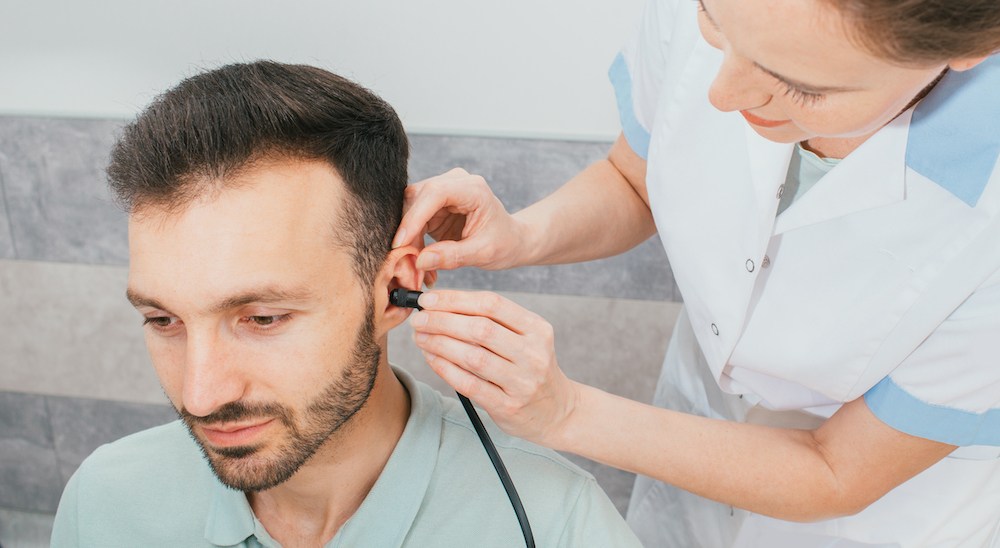How AI is Shaping the Future of Hearing Health
Artificial intelligence has become part of everyday life in ways most

By: admin | April 24, 2025
The ways we test hearing today have come a long way from the simple tuning forks and whisper tests of the past. Modern hearing assessments now use sophisticated equipment and techniques that give us much more detailed information about your hearing abilities. These improvements matter because they help us pinpoint exactly what’s happening with your hearing – whether it’s difficulty with certain sound frequencies, challenges in noisy environments, or issues with how your brain processes what you hear. Better testing leads to better solutions, which means you get hearing care that truly addresses your specific needs.
We know that taking a hearing test can feel intimidating for many people. You might worry about the results or feel unsure about what the testing process involves. That’s why advances in hearing test technology aren’t just about getting more accurate readings – they’re also about making the experience more comfortable, faster, and more informative for you. From user-friendly equipment to tests that simulate real-world listening situations, these improvements help both you and your audiologist better understand your hearing health. With clearer information comes more effective treatment options, giving you the best chance to stay connected to conversations, enjoy music, and participate fully in the activities you value most.
Hearing tests are a key part of understanding your overall hearing health, even if you haven’t noticed any major changes in how you hear. These evaluations do more than just measure whether or not you can hear certain sounds – they help identify the specific frequencies and environments that may be more difficult for you. Hearing loss often develops gradually, and many people adjust to it without realizing how much they’re missing. A hearing test with an audiologist gives you a clear, detailed picture of your current hearing ability, helping catch early signs of changes that might otherwise go unnoticed.
An audiologist uses specialized tools and techniques to assess how well sound travels through your ears and is processed by your brain. This isn’t a one-size-fits-all approach – your test will be tailored to your unique needs and any concerns you may have. The results not only help pinpoint the type and degree of hearing loss, but also provide insight into what might be causing it. Whether it’s related to aging, noise exposure, or a medical condition, these answers guide your next steps. Understanding the “why” behind any hearing difficulty is just as important as knowing the “what.”
Regular hearing tests also give you a baseline to compare against in the future. If you do need support, like hearing aids or assistive technology, the audiologist uses your test results to make personalized recommendations. It’s about more than diagnosing a problem – it’s about giving you the tools and information to protect and improve your hearing as part of your long-term health. Whether you’re experiencing changes or just want peace of mind, a hearing test is a smart, proactive way to stay informed.
Hearing exams have changed a lot over the years, thanks to technology. Today’s hearing assessments use advanced technology to deliver more accurate and detailed results. These high-tech solutions offer a new level of detail in evaluating your hearing health.
One recent update is digital audiometry. This computer-based testing system accurately measures your ability to hear different frequencies and volumes. It also provides a detailed analysis of your ability to distinguish between similar-sounding words, essential for understanding speech in noisy environments.
Another significant tech update is otoacoustic emissions (OAE) testing. This non-invasive procedure measures sounds produced by the inner ear in response to a stimulus. It provides valuable insights into the functioning of your cochlea – or, how well your inner ear is working.
These tech advancements not only improve accuracy but also make exams less intrusive and more comfortable for you. So, think of your next check-up not just as a regular appointment, but as an opportunity to benefit from state-of-the-art technology designed to provide the best care!
Artificial Intelligence (AI) is a game-changer in the realm of hearing health and technology. AI’s influence on hearing checks is transformative, bringing about significant enhancements in both the process and outcomes of hearing assessments.
AI-powered systems can self-learn, meaning they can improve their performance over time based on previous experiences. This is especially helpful when analyzing complex patterns in your hearing test data. With each check-up, these smart systems get better at identifying subtle changes or trends that might otherwise go unnoticed.
AI can automate certain aspects of a hearing test, such as adjusting the volume or frequency during a test based on your responses. This automation allows for more efficient tests and reduces potential human error.
Accurate hearing tests are vital in determining the right course of action for any hearing concerns. However, understanding how these tests work and what they mean for you can be tricky. Fortunately, audiologists have advanced tools and technologies that provide detailed results.
These results not only pinpoint your exact level of hearing loss but also identify specific frequencies where you may have difficulty. This allows them to customize treatment plans precisely tailored to your needs, ensuring a more effective approach towards managing your hearing health. Therefore, when you go in for your next check-up, consider it not just a routine test; it’s an opportunity for personalized care based on precision and accuracy!
The advent of new technologies in hearing care has introduced a range of possibilities, offering solutions that are tailored to your unique hearing needs. One of the most significant advancements is the use of sophisticated software algorithms in designing hearing aids. These algorithms analyze your specific pattern of hearing loss and adjust the device accordingly. This means that the sound you hear through your hearing aid is customized to enhance those frequencies where you need it most.
In addition, digital technology has given you the power to fine-tune your own devices. With smartphone apps and wireless connectivity, you can adjust settings on your hearing aids according to different environments – whether you’re in a quiet room or a bustling restaurant.
The latest innovations in this field aim to deliver accurate results while ensuring that the testing process is as comfortable and stress-free as possible for you.
Consider immittance audiometry, for example – a non-invasive technique that measures how well your eardrum and other middle ear structures are working. This method uses a soft probe to send sounds into your ear and measure the sound that bounces back. The test is quick, painless, and can provide valuable information about possible causes of hearing loss.
Another great example is automated auditory brainstem response (AABR) testing. This tech-savvy method uses sensors placed on your head to detect how well your auditory nerve transmits signals from the ear to the brain. It’s completely painless and can even be performed while you’re sleeping!
These advancements have significantly improved patient comfort during hearing tests. So next time you’re due for an assessment, take comfort in knowing that you’ll experience an examination designed with both precision and your comfort in mind.
As we discuss the evolving landscape of hearing health, it’s important to compare traditional and modern approaches in hearing evaluations. Each has its merits and plays a significant role in assessing your hearing health.
Traditional methods, like pure-tone audiometry or speech audiometry, have stood the test of time. These reliable techniques provide solid results and are still considered the gold standard in many clinics. They’re simple yet effective ways to measure your ability to hear various frequencies and understand speech. However, with the advent of new technology, these newer methods is their ability to provide a more detailed analysis of your inner ear’s function.
While traditional methods focus on what you can hear, modern approaches delve deeper, investigating how well your ear is working internally. This added layer of insight allows for an even more personalized treatment plan.
Both traditional and modern methods play a crucial part in comprehensive hearing evaluations. They complement each other by providing a complete picture of your auditory health – from understanding what sounds you can perceive to how effectively your inner ear processes those sounds.
In today’s world, technology is not just a tool for work or entertainment. It’s a powerful ally in enhancing our social interactions and communication abilities, especially for those managing hearing loss. Technological advancements in hearing care have opened up new avenues to stay connected with the world around us.
Consider the latest digital hearing aids. These devices are not merely about amplifying sound; they’re about enriching your auditory experience. With features like background noise reduction and speech enhancement, these smart devices can make conversations clearer and more enjoyable – even in noisy environments!
Additionally, many of these high-tech hearing aids can be synced with your smartphone or other digital devices via Bluetooth. This means you can stream phone calls, music, or podcasts directly into your ears! With this feature at your disposal, your hearing loss doesn’t limit you. Instead, you have the freedom to fully participate in social interactions and enjoy life’s sounds to the fullest.
Consider teleaudiology, for instance. This approach allows for remote hearing assessments using internet-based technologies. With this innovation, you can have your hearing tested from the comfort of your own home! It’s a major leap forward in making hearing care more accessible and convenient for everyone.
Another noteworthy advancement is 3D Ear Scanning technology. This high-tech tool uses laser technology to create a detailed 3D model of your ear canal. The scan is quick, comfortable, and provides extremely accurate measurements – vital for customizing devices like hearing aids or earplugs to fit perfectly in your ear.
Today’s hearing tests aren’t just more advanced – they’re more helpful, more specific, and more focused on your daily life. We’ve moved well beyond the basic tools of the past to offer assessments that reflect real listening situations, giving you a clearer picture of what’s actually happening with your hearing. When you take part in these evaluations, you’re not just checking a box – you’re giving yourself access to better answers and more meaningful options. Whether you’re just curious about your hearing or already noticing changes, modern testing helps you understand what’s going on in a way that feels relevant and personal.
At Stone Audiology, we believe that better information leads to better care. That’s why we use the latest hearing test technology – not just for the sake of precision, but to make sure you leave your appointment with a deeper understanding of your hearing and how we can help. The process is designed to be smooth and reassuring, with tools that give us the insight we need to tailor your care to your specific situation.
You can contact our team at one of our convenient New York locations by calling:
Or, if you’re located in Pennsylvania, feel free to reach our staff at:
Experience firsthand how these advancements in hearing test technology can enhance your journey towards optimal hearing health.
Tags: ABR tests, OAE tests, speech tests

Artificial intelligence has become part of everyday life in ways most
By: admin | August 21, 2025

The ways we test hearing today have come a long way from the simple tuning
By: admin | April 24, 2025

Clear hearing shapes how you experience daily life – from chatting with
By: admin | March 21, 2025
